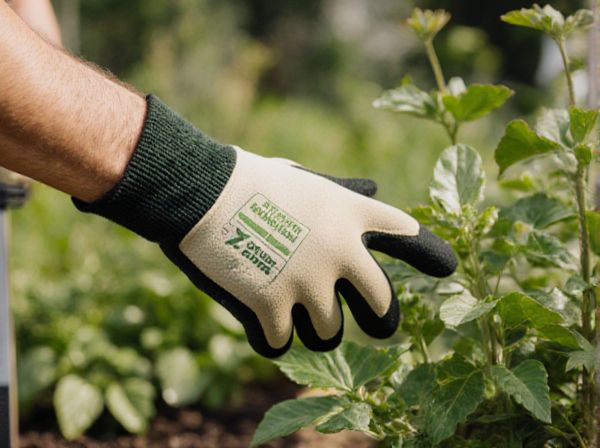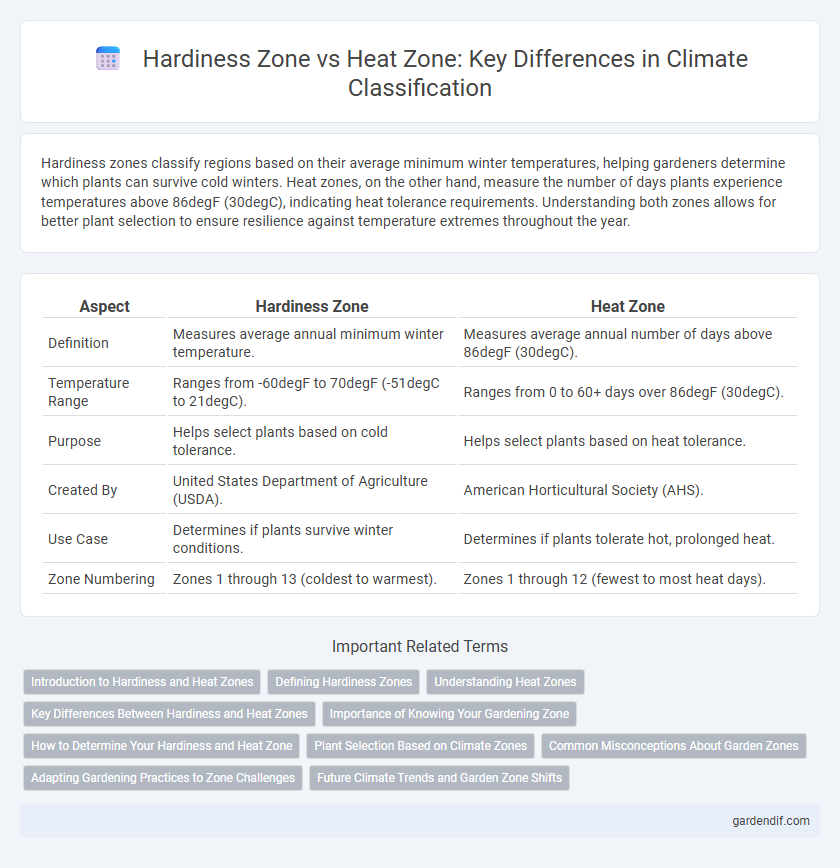
Hardiness zone vs Heat zone Illustration
Hardiness zones classify regions based on their average minimum winter temperatures, helping gardeners determine which plants can survive cold winters. Heat zones, on the other hand, measure the number of days plants experience temperatures above 86degF (30degC), indicating heat tolerance requirements. Understanding both zones allows for better plant selection to ensure resilience against temperature extremes throughout the year.
Table of Comparison
| Aspect | Hardiness Zone | Heat Zone |
|---|---|---|
| Definition | Measures average annual minimum winter temperature. | Measures average annual number of days above 86degF (30degC). |
| Temperature Range | Ranges from -60degF to 70degF (-51degC to 21degC). | Ranges from 0 to 60+ days over 86degF (30degC). |
| Purpose | Helps select plants based on cold tolerance. | Helps select plants based on heat tolerance. |
| Created By | United States Department of Agriculture (USDA). | American Horticultural Society (AHS). |
| Use Case | Determines if plants survive winter conditions. | Determines if plants tolerate hot, prolonged heat. |
| Zone Numbering | Zones 1 through 13 (coldest to warmest). | Zones 1 through 12 (fewest to most heat days). |
Introduction to Hardiness and Heat Zones
Hardiness zones classify regions based on the minimum winter temperatures plants can endure, guiding gardeners in selecting cold-tolerant species. Heat zones measure the number of days per year that reach temperatures above 86degF (30degC), indicating plant heat tolerance requirements. Understanding both zones helps optimize plant survival and growth by matching species to local temperature extremes.
Defining Hardiness Zones
Hardiness zones classify regions based on average minimum winter temperatures, guiding plant survival through cold exposure. The U.S. Department of Agriculture (USDA) developed a widely used hardiness zone map, ranging from Zone 1 (coldest) to Zone 13 (warmest). These zones help gardeners and growers select plants that can withstand local winter conditions, ensuring better growth and resilience.
Understanding Heat Zones
Heat zones map the number of heat days above 86degF (30degC) plants experience, offering insight into plant tolerance during hot summer conditions. Unlike hardiness zones that focus on minimum winter temperatures, heat zones help gardeners select species resilient to prolonged heat stress. Understanding heat zones is essential for optimizing landscape choices and ensuring plant survival in increasingly warmer climates.
Key Differences Between Hardiness and Heat Zones
Hardiness zones measure the average minimum winter temperatures, indicating plant survival thresholds, while heat zones assess the average number of days with temperatures above 86degF, reflecting heat tolerance. These zones differ in focus, with hardiness zones guiding cold tolerance and heat zones highlighting heat stress limits. Understanding both zones ensures optimal plant selection based on comprehensive temperature extremes throughout the year.
Importance of Knowing Your Gardening Zone
Understanding your gardening zone, whether a Hardiness Zone or Heat Zone, is crucial for selecting plants that thrive in your climate conditions, ensuring successful growth and reduced maintenance. Hardiness Zones map the minimum winter temperatures to guide plant cold tolerance, while Heat Zones indicate the number of days plants experience high heat, important for heat-sensitive species. Knowing both zones helps gardeners optimize planting schedules, improve plant survival rates, and create sustainable gardens adapted to local climate challenges.
How to Determine Your Hardiness and Heat Zone
Determine your hardiness zone by identifying the average annual minimum winter temperature in your area, typically provided by the USDA Hardiness Zone Map, which helps predict plant survival rates during cold conditions. Assess your heat zone using the American Horticultural Society's Heat Zone Map, which counts the number of days annually with temperatures above 86degF, indicating heat tolerance for plants. Combining both hardiness and heat zone information provides a comprehensive understanding of climate suitability for selecting appropriate plants.
Plant Selection Based on Climate Zones
Hardiness zones categorize regions by their minimum winter temperatures, guiding plant selection for cold tolerance, while heat zones measure the average number of days above 86degF, indicating a plant's heat endurance. Selecting plants that align with both hardiness and heat zones ensures optimal growth by matching species to the precise cold and heat stress levels they can withstand. Understanding these complementary climate zones allows gardeners and landscapers to choose resilient plants, enhancing survival and reducing maintenance in varying climates.
Common Misconceptions About Garden Zones
Hardiness zones classify regions based on minimum winter temperatures, helping gardeners select plants that can survive cold conditions, while heat zones measure the average number of days temperatures exceed 86degF, indicating heat tolerance. A common misconception is that hardiness zones alone determine plant survival, ignoring heat stress that can damage plants despite cold hardiness. Understanding both zones is crucial for optimal plant selection, especially as climate change intensifies temperature extremes.
Adapting Gardening Practices to Zone Challenges
Hardiness zones measure the coldest winter temperatures plants can endure, while heat zones indicate the number of days with temperatures above 86degF that affect plant stress. Adapting gardening practices requires selecting plants suited to both zones, using mulching and shading techniques to mitigate heat, and employing frost protection strategies during cold spells. Understanding the combined influence of USDA Hardiness Zones and AHS Heat Zones allows gardeners to optimize plant health and maximize garden productivity.
Future Climate Trends and Garden Zone Shifts
Future climate trends indicate a shift in hardiness zones due to rising global temperatures, causing many regions to experience warmer minimum winter temperatures and enabling new plant varieties to thrive. Heat zones, which measure the number of days above 86degF, are also expanding, affecting plant stress and water requirements in gardens. Gardeners must adapt to these shifting zones by selecting heat-tolerant plants and adjusting planting schedules to ensure sustainable growth in changing climates.
Hardiness zone vs Heat zone Infographic

 gardendif.com
gardendif.com